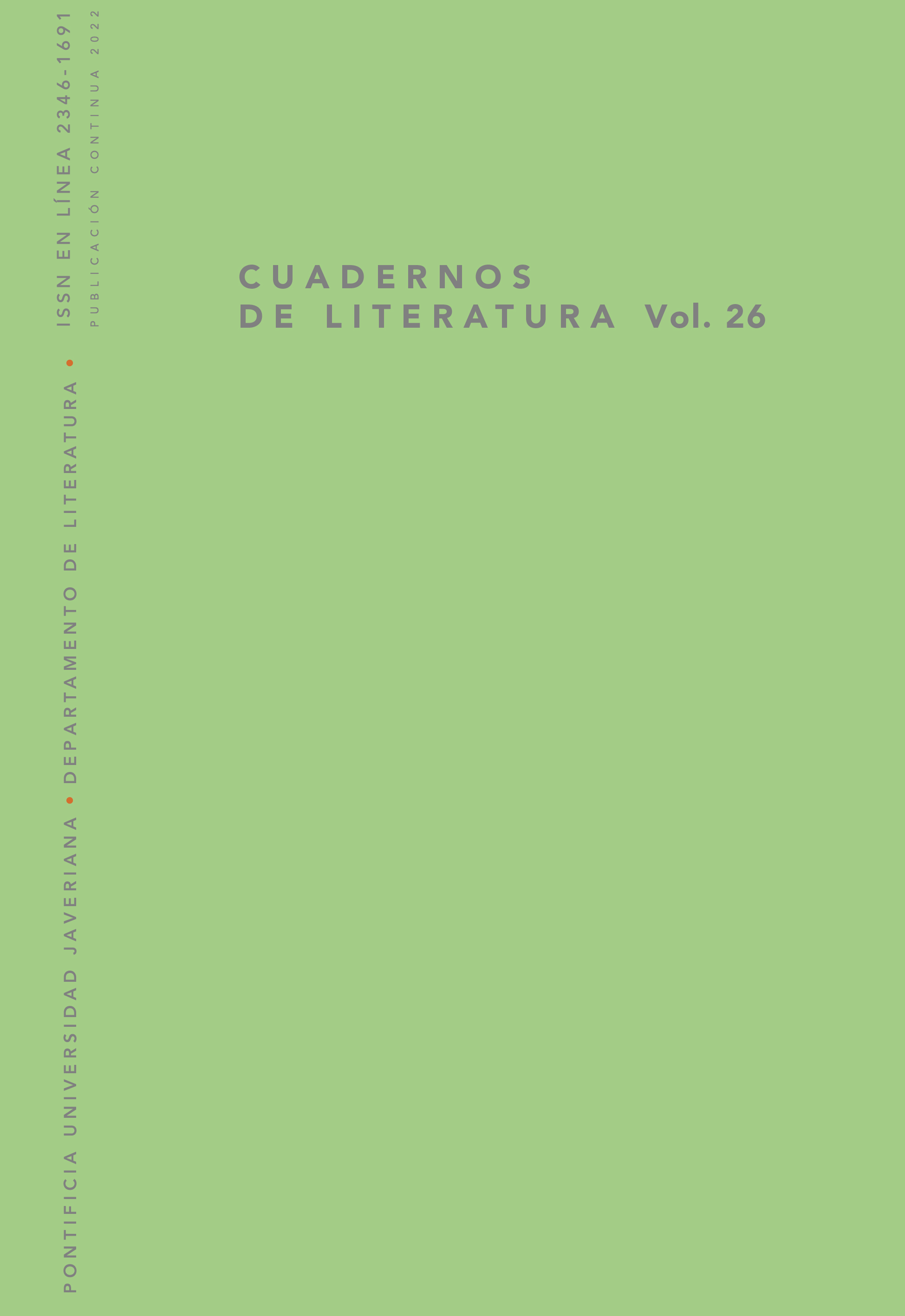Resumen
Este ensayo examina la obra de los autores-artistas Negma Coy y Edgar Calel, originarios de Chi Xot (San Juan Comalapa, Chimaltenango, Guatemala), a través del ts’íib. Irma Otzoy, Gaspar Pedro González y Pedro Uc Be, intelectuales mayas, explican el ts’íib como una producción artística que rebasa los límites de la palabra escrita. El ts’íib revela la palabra escrita, la grafía latina específicamente, como un instrumento más dentro de otras textualidades que participan en la creación de se mismo espacio de deleite y aprendizaje.
Aguilar Gil, Yásnaya Elena. “¿Literatura? ¿Indígena?”. Letras Libres, marzo de 2015, https://www.letraslibres.com/mexico-espana/libros/literatura-indigena.
Ak’abal, Humberto. “Humberto Ak’abal: ‘Nombrar a un pájaro es cantar con él’”. Jornal do poesia, entrevista con Franklin Fernández, http://www.jornaldepoesia.jor.br/bh25akabal.htm.
Allen, Chadwick. Trans-Indigenous: Methodologies for a Global Native Literary Studies. University of Minnesota Press, 2012.
Arias, Arturo. Recovering Lost Footprints: Contemporary Maya Narratives. Vol. 1, SUNY Press, 2017.
Calel, Edgar. Comunicación personal con Rita M. Palacios. 28 enero de 2019.
---. Kit kit kit. Comalapa, 2014.
Colop, Sam, traductor. Popol wuj (edición popular). F&G editores, 2012.
Coy, Negma. Kikotem. Historias, cuentos, poesía kaqchikel. Cholsamaj, 2019.
---. Tz’ula’. Guardianes de los caminos. Amargord, 2019.
---. Wa’ix-maj. Edición de la autora, s. f.
---. XXXK’. Letra Nómada, 2016.
Coy, Negma, et. al. Alaxinäq pa taq kichelaj. Nacida entre montañas, poesía de Comalapa. Ajtzib’, 2017.
Cultivando un futuro: Edgar Calel. Dirigido por Javier Donis, ProDesarrolloPro, 2014, https://www.youtube.com/watch?v=m_aSNa-AJ3g.
Daibert, Raphael. “I drag you with me: ancestry and contemporary practice”. ArtsEverywhere, 2017, http://artseverywhere.ca/2017/03/06/i-drag-you-with-me/.
González, Pedro. Kotz’ib’. Nuestra literatura maya. Fundación Yaxté, 1997.
Gumeta, Chary. También en el sur se matan palomas. Traducido por Negma Coy, La Tinta del Silencio, 2017.
Heath Justice, Daniel. Why Indigenous Literatures Matter. Wilfrid Laurier Press, 2018.
“Interação com el artista guatemalteco Edgar Calel”. Zine Zona da Mata, 2016, https://issuu.com/zonadamata/docs/zinezdm_final_2.
Kumatzin wuj ka’i’. Códice de Madrid. Cholsamaj, 2008.
Lacadena García Gallo, Alfonso. “Apuntes para un estudio sobre literatura maya antigua”. Text and Context: Yucatec Maya Literature in a Diachronic Perspective, editado por Antje Gunsenheimer, Tsubasa Okoshi Harada, John F. Chuchiak y Shaker Verlag, 2009, pp. 31-52.
Lepe Lira, Luz María. Relatos de diferencia y literatura indígena. Travesías por el sistema mundo. Laboratorio Nacional de Materiales Orales; Escuela Nacional de Estudios Superiores, unidad Morelia; Universidad Autónoma de Querétaro; Grañén Porrúa, 2018.
Llanes-Ortiz, Genner. “Yaan muuk’ ich cha’anil / El potencial de Cha’anil: Un concepto maya para la revitalización lingüística”. Ichan Teolotl / La Casa del Tecolote, vol. 26, n.º 301, 2015, pp. 28-30.
Loayes, Wilson, et. al. Palabras para colgar en los árboles. Breve selección de poesía guatemalteca. Metáfora Editores, 2013.
Otzoy, Irma. “Identidad y trajes mayas”. Mesoamérica, vol. 23, n.º 23, 1992, pp. 95-112.
Rocha Vivas, Miguel. Mingas de la palabra. Textualidades oralitegráficas y visiones de cabeza en las oralituras y literaturas indígenas contemporáneas. Casa de las Américas, 2016.
Ruiz, Mikel. “Ruptura de una tradición inventada I”. Tierra Adentro, agosto de 2019, https://www.tierraadentro.cultura.gob.mx/38006/.
Salazar Ochoa, Jonathan. “Edgar Calel y por qué siempre llega la misma mara a las exposiciones”. Barrancópolis, septiempre 7 de 2017, https://barrancopolis.com/calel/.
Salazar Tetzagüic, Manuel de Jesús. Rupach’uxik Kina’oj Qati’t Qamama’ / Características de la literatura maya Kaqchikel. Cholsamaj, 1995.
São Paulo Estado da Cultura. “Projeto Kaqchikel”. http://estadodacultura.sp.gov.br/evento/3189/.
Tapia, Jorge. Educación, comunidad y literatura. Condiciones para la emergencia de una literatura indígena contemporánea (caso bröran-térraba en Costa Rica). Instituto Internacional de Literatura Iberoamericana, 2019.
Tedlock, Barbara, y Dennis Tedlock. “Text and Textile: Language and Technology in the Arts of the Quiché Maya”. Journal of Anthropological Research, vol. 41, n.º 2, 1985, pp. 121-146.
Uc Be, Pedro. “La escritura maya: Una muestra de creación. Uts’íibil ts’íib”. Sinfín. Revista Electrónica, n.º 15, 2015, pp. 10-12, https://www.revistasinfin.com/ensayos/la-escritura-maya-una-muestra-de-creacion-utsiibil-tsiib/.
Wellen, Laura A. L. “The Face of The Land that my Feet Have Seen”. Piedrín, octubre de 2017, https://www.piedrin.com/pebbles/2017/10/13/the-face-of-the-land-that-my-feet-have-seen.
---. “Una piedra y la lluvia”. Piedrín, mayo de 2017, https://www.piedrin.com/piedrnes/2017/4/10/una-piedra-y-la-lluvia.
Womack, Craig S. Red on Red: Native American Literary Separatism. University of Minnesota Press, 1999.
Worley, Paul M., y Rita M. Palacios. Unwriting Maya Literature: Ts’íib as Recorded Knowledge. University of Arizona Press, 2019.

Esta obra está bajo una licencia internacional Creative Commons Atribución 4.0.


